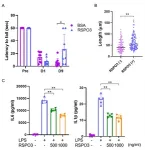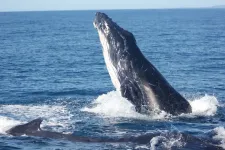(Press-News.org) Astronomers have found that supermassive black holes obscured by dust are more likely to grow and release tremendous amounts of energy when they are inside galaxies that are expected to collide with a neighbouring galaxy. The new work, led by researchers from Newcastle University, is published in Monthly Notices of the Royal Astronomical Society.
Galaxies, including our own Milky Way, contain supermassive black holes at their centres. They have masses equivalent to millions, or even billions, times that of our Sun. These black holes grow by ‘eating’ gas that falls on to them. However, what drives the gas close enough to the black holes for this to happen is an ongoing mystery.
One possibility is that when galaxies are close enough together, they are likely to be gravitationally pulled towards each other and ‘merge’ into one larger galaxy.
In the final stages of its journey into a black hole, gas lights up and produces a huge amount of energy. This energy is typically detected using visible light or X-rays. However, the astronomers conducting this study were only able to detect the growing black holes using infrared light. The team made use of data from many different telescopes, including the Hubble Space Telescope and infrared Spitzer Space Telescope.
The researchers developed a new technique to determine how likely it is that two galaxies are very close together and are expected to collide in the future. They applied this new method to hundreds of thousands of galaxies in the distant universe (looking at galaxies formed 2 to 6 billion years after the Big Bang) in an attempt to better understand the so-called ‘cosmic noon’, a time when most of the Universe’s galaxy and black hole growth is expected to have taken place.
Understanding how black holes grew during this time is fundamental in modern day galactic research, especially as it may give us an insight into the supermassive black hole situated inside the Milky Way, and how our galaxy evolved over time.
As they are so far away, only a small number of cosmic noon galaxies meet the required criteria to get precise measurements of their distances. This makes it very difficult to know with high precision if any two galaxies are very close to each other.
This study presents a new statistical method to overcome the previous limitations of measuring accurate distances of galaxies and supermassive black holes at cosmic noon. It applies a statistical approach to determine galaxy distances using images at different wavelengths and removes the need for spectroscopic distance measurements for individual galaxies.
Data arriving from the James Webb Space Telescope over the coming years is expected to revolutionise studies in the infrared and reveal even more secrets about how these dusty black holes grow.
Sean Dougherty, postgraduate student at Newcastle University and lead author of the paper, says, “Our novel approach looks at hundreds of thousands of distant galaxies with a statistical approach and asks how likely any two galaxies are to be close together and so likely to be on a collision course.”
Dr Chris Harrison, co-author of the study, “These supermassive black holes are very challenging to find because the X-ray light, which astronomers have typically used to find these growing black holes, is blocked, and not detected by our telescopes. But these same black holes can be found using infrared light, which is produced by the hot dust surrounding them.”
He adds, “The difficulty in finding these black holes and in establishing precise distance measurements explains why this result has previously been challenging to pin down these distant ‘cosmic noon’ galaxies. With JWST we are expecting to find many more of these hidden growing black holes. JWST will be far better at finding them, therefore we will have many more to study, including ones that are the most difficult to find. From there, we can do more to understand the dust that surrounds them, and find out how many are hidden in distant galaxies.”
END
Hidden supermassive black holes brought to life by galaxies on collision course
2023-05-11
ELSE PRESS RELEASES FROM THIS DATE:
Rooftop solar panels could power one third of US manufacturing sector
2023-05-11
Rooftop solar arrays have the potential to meet the annual electricity demands of up to 35% of US manufacturing sectors.
On-site sources of renewable energy currently supply less than 0.1% of industrial electricity demand in the US.
The industrial sector accounts for 38% of global energy consumption and 37% of greenhouse gas emissions.
Despite having the potential to cover 13.6% of the national electricity demand, rooftop solar arrays currently account for just 2.2% of the electricity grid mix.
Mounted on the rooftops ...
Students positive towards AI, but uncertain about what counts as cheating
2023-05-11
Students in Sweden are positive towards AI tools such as ChatGPT in education, but 62 percent believe that using chatbots during exams is cheating. However, where the boundary for cheating lies is highly unclear. This is shown in a survey from Chalmers University of Technology, which is the first large-scale study in Europe to investigate students' attitudes towards artificial intelligence in higher education.
“I am afraid of AI and what it could mean for the future.”
“Don't worry so much! Keep up with the development and adapt your teaching ...
Health worker shortages strongly linked to excess deaths
2023-05-11
Shortages of health workers such as doctors, nurses and midwifery staff are strongly associated with higher death rates, especially for certain diseases such as neglected tropical diseases and malaria, pregnancy and birth complications, diabetes and kidney diseases, finds an analysis of 172 countries and territories, published by The BMJ today.
The results show that, although inequalities in health workforces have been decreasing globally over the past 30 years, they continue to have a substantial ...
Experts call for monitoring of respiratory vaccine after trials suggest possible increase in preterm births
2023-05-11
Experts have called for further scrutiny of a new Pfizer vaccine given during pregnancy to prevent respiratory infection in infants, after trials of a similar GSK vaccine were stopped after a rise in preterm birth and infant deaths.
Pfizer says its vaccine is safe and effective, but experts contacted as part of an investigation published by The BMJ today, say Pfizer’s trial data should be reviewed in light of the signal for preterm births seen in GSK’s trial.
Pfizer’s ...
Jellybeans – a sweet solution for overcrowded circuitry in quantum computer chips
2023-05-11
The silicon microchips of future quantum computers will be packed with millions, if not billions of qubits – the basic units of quantum information – to solve the greatest problems facing humanity. And with millions of qubits needing millions of wires in the microchip circuitry, it was always going to get cramped in there.
But now engineers at UNSW Sydney have made an important step towards solving a long-standing problem about giving their qubits more breathing space -- and it all revolves around jellybeans.
Not the kind we rely on for a sugar hit to get us past the 3pm slump. But jellybean quantum dots –elongated areas between qubit ...
Dangerous snoring may affect one in five people, but most sufferers do not know they have a problem
2023-05-11
Around one in five people may be suffering with obstructive sleep apnoea (OSA), according to a study published today (Thursday) in the ERJ Open Research [1].
People with OSA often snore loudly, their breathing starts and stops during the night, and they may wake up several times. Not only does this cause tiredness, but it can also increase the risk of high blood pressure, stroke, heart disease and type 2 diabetes.
Treatments and lifestyle changes can help people with OSA. However, ...
Research reveals majority of gig economy workers are earning below minimum wage
2023-05-11
As the cost of living continues to spiral, a new report shows more than half of gig economy workers in the UK are paid below the minimum wage.
The first-of-its-kind study, led by the University of Bristol, found 52% of gig workers doing jobs ranging from data entry to food delivery were earning below the minimum wage. On average respondents were earning £8.97 per hour – around 15% below the current UK minimum wage, which rose to £10.42 this month.
More than three-quarters (76%) of survey respondents also experienced work-related ...
You are what you eat: healthier diet may improve fitness
2023-05-11
Sophia Antipolis, 11 May 2023: A healthy diet is associated with greater physical fitness in middle-aged adults, according to research published today in the European Journal of Preventive Cardiology, a journal of the European Society of Cardiology (ESC).1
“This study provides some of the strongest and most rigorous data thus far to support the connection that better diets may lead to higher fitness,” said study author Dr. Michael Mi of Beth Israel Deaconess Medical Center, Boston, US. “The improvement in fitness we observed in participants with better diets was similar to the effect of taking 4,000 more steps each ...
Risk of long COVID higher for people living in most deprived areas
2023-05-11
New research led by the universities of Southampton and Oxford has found that the risk of long COVID is strongly associated with area-level deprivation, with the odds of having long COVID 46 percent higher for people from the most deprived areas, compared to those in the least deprived areas.
Published in the Journal of the Royal Society of Medicine, the study analysed over 200,000 working-age adults and is the first to quantify the association between long COVID and socioeconomic status across a range of occupation sectors.
Analysing data from the Office ...
Singing humpback whales respond to wind noise, but not boats
2023-05-11
A University of Queensland study has found humpback whales sing louder when the wind is noisy, but don’t have the same reaction to boat engines.
Research lead Dr Elisa Girola from UQ’s Faculty of Science said this quirk of whale evolution could have consequences for breeding and behaviour.
“Humpback whales evolved over millions of years with noise from natural sources but noise from man-made vessels is foreign to their instincts,” Dr Girola said.
“It’s a ...




